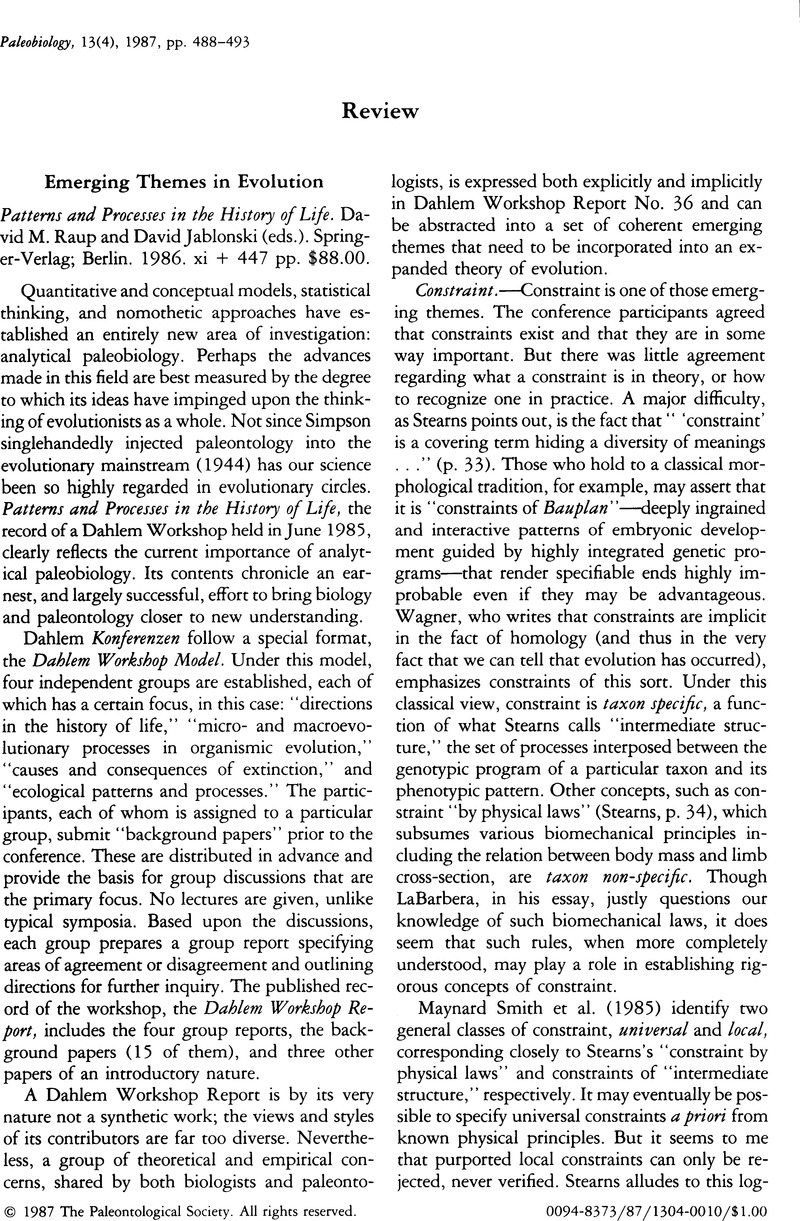No CrossRef data available.
Article contents
Emerging Themes in Evolution - Patterns and Processes in the History of Life. David M. Raup and David Jablonski (eds.). Springer-Verlag; Berlin. 1986. xi + 447 pp. $88.00.
Published online by Cambridge University Press: 08 April 2016
Abstract
An abstract is not available for this content so a preview has been provided. Please use the Get access link above for information on how to access this content.

- Type
- Review
- Information
- Copyright
- Copyright © The Paleontological Society
References
Literature Cited
Alvarez, L. W., Alvarez, W., Asaro, F., and Michel, H. V. 1980. Extraterrestrial cause for the Cretaceous-Tertiary extinction. Science. 208:1095–1108.CrossRefGoogle ScholarPubMed
Charlesworth, B., Lande, R., and Slatkin, M. 1982. A neo-Darwinian commentary on macroevolution. Evolution. 36:474–498.Google ScholarPubMed
Eldredge, N. and Gould, S. J. 1972. Punctuated equilibria: an alternative to phyletic gradualism. Pp. 82–115. In: Schopf, T. J. M., ed. Models in Paleobiology. Freeman, Cooper, and Co.; San Francisco.Google Scholar
Gould, S. J. 1982. The meaning of punctuated equilibrium and its role in validating a hierarchical approach to macroevolution. Pp. 83–104. In: Milkman, R., ed. Perspectives on Evolution. Sinauer Assoc. Inc.; Sunderland, Massachusetts.Google Scholar
Gould, S. J. 1985. The paradox of the first tier: an agenda for paleobiology. Paleobiology. 11:2–12.Google Scholar
Gould, S. J. 1986. Evolution and the triumph of homology, or why history matters. Am. Scientist. 74:60–69.Google Scholar
Gould, S. J. and Eldredge, N. 1977. Punctuated equilibria: the tempo and mode of evolution reconsidered. Paleobiology. 3:115–151.CrossRefGoogle Scholar
Jablonski, D. 1986. Background and mass extinctions: the alternation of macroevolutionary regimes. Science. 231:129–133.CrossRefGoogle ScholarPubMed
Levinton, J. S. 1983. Stasis in progress: the empirical basis of macroevolution. Ann. Rev. Ecol. Syst. 14:103–137.Google Scholar
Luo, H. 1984. Sinian-Cambrian boundary stratotype section at Meishucun, Jinning, Yunnan, China. 154 pp., 22 pl.People's Publishing House; Beijing.Google Scholar
Maynard Smith, J., Burian, R., Kauffman, S., Alberch, P., Campbell, J., Goodwin, B., Lande, R., Raup, D., and Wolpert, L. 1985. Developmental constraints and evolution. Quart. Rev. Biol. 60:265–287.Google Scholar
Mayo, D. G. and Gilinsky, N. L.Models of group selection. Philosophy of Science. (in press).Google Scholar
Mayr, E. 1954. Change of genetic environment and evolution. Pp. 157–180. In: Huxley, J., ed. Evolution as a Process. Allen and Unwin; London.Google Scholar
Mayr, E. 1963. Animal Species and Evolution. 797 pp. Belknap Press of Harvard University Press; Cambridge, Massachusetts.Google Scholar
Mayr, E. 1982. Processes of speciation in animals. Pp. 1–20. In: Barigozzi, C., ed. Mechanisms of Speciation. A. R. Liss; New York.Google Scholar
Raup, D. M. and Sepkoski, J. J. Jr. 1982. Mass extinctions in the marine fossil record. Science. 215:1501–1503.Google Scholar
Raup, D. M. and Sepkoski, J. J. Jr. 1984. Periodicity of extinctions in the geologic past. Proc. Nat. Acad. Sci. USA. 81:801–805.Google Scholar
Raup, D. M. and Sepkoski, J. J. Jr. 1986. Periodic extinction of families and genera. Science. 231:833–836.CrossRefGoogle ScholarPubMed
Sepkoski, J. J. Jr. 1982. A compendium of fossil marine families. 125 pp. Milwaukee Pub. Mus. Contr. Biol. Geol. No. 51.Google Scholar
Simpson, G. G. 1944. Tempo and Mode in Evolution. 237 pp. Columbia University Press; New York.Google Scholar
Sober, E. 1980. Holism, individualism, and the units of selection. Pp. 93–121. In: Asquith, P. and Giere, R., eds. PSA 1980, vol. 2. Philosophy of Science Assoc.; East Lansing, Michigan.Google Scholar
Stanley, S. M. 1975. A theory of evolution above the species level. Proc. Nat. Acad. Sci. USA. 72:646–650.Google Scholar
Stanley, S. M. 1979. Macroevolution, Pattern and Process. 332 pp. W. H. Freeman and Co.; San Francisco.Google Scholar
Vrba, E. S. 1980. Evolution, species and fossils: how does life evolve? S. African J. Sci. 76:61–84.Google Scholar
Vrba, E. S. 1983. Macroevolutionary trends: new perspectives on the roles of adaptation and incidental effect. Science. 221:387–389.CrossRefGoogle ScholarPubMed
Vrba, E. S. and Eldredge, N. 1984. Individuals, hierarchies and processes: towards a more complete evolutionary theory. Paleobiology. 10:146–171.CrossRefGoogle Scholar
Wynne-Edwards, V. C. 1962. Animal Dispersion in Relation to Social Behavior. 653 pp. Oliver & Boyd; Edinburgh.Google Scholar


